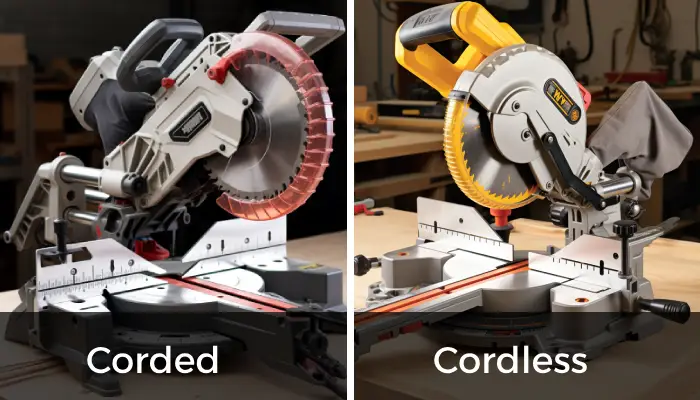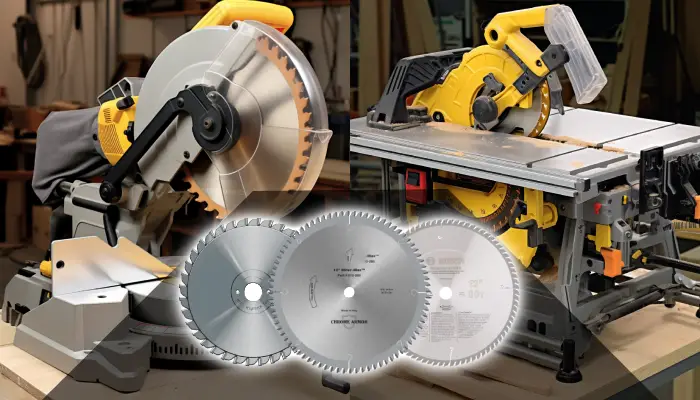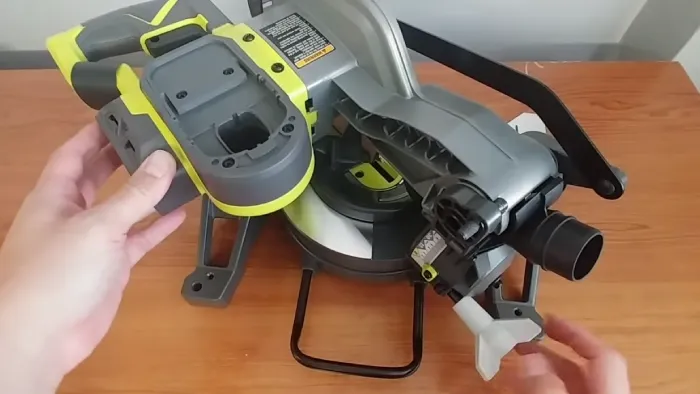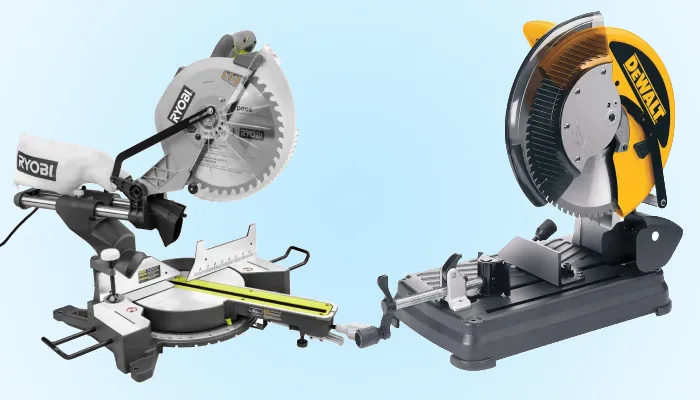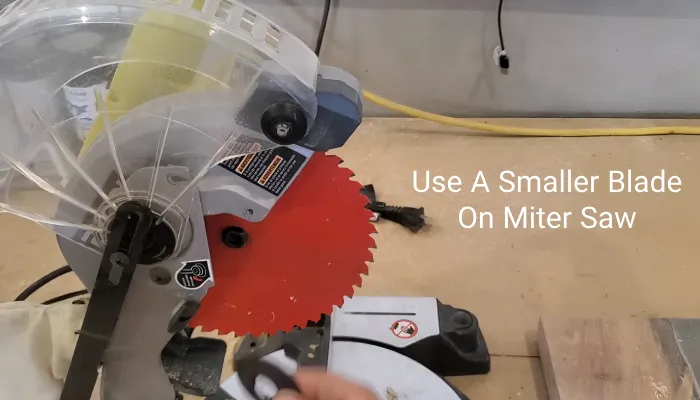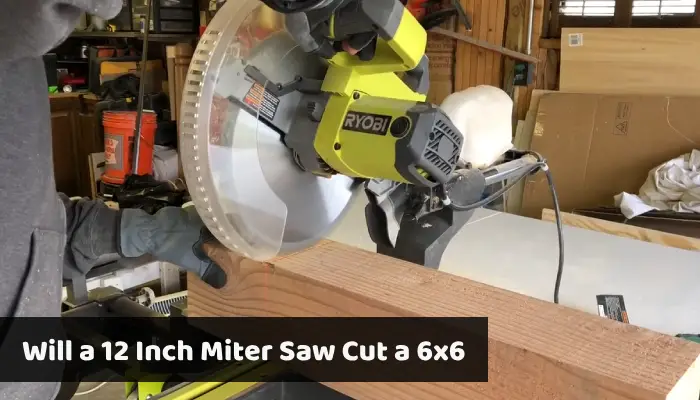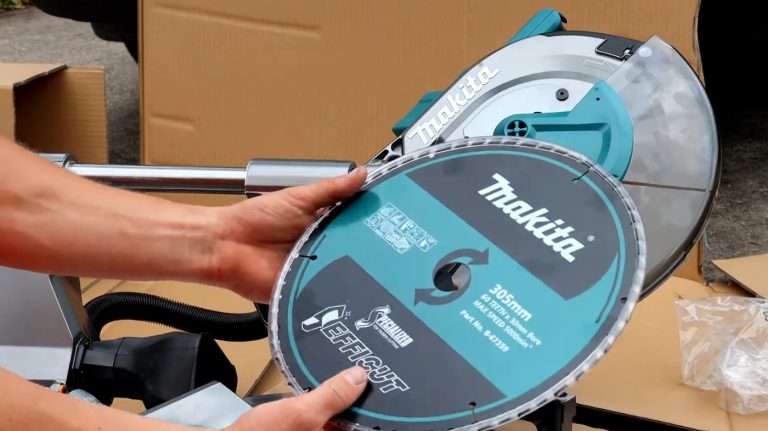Corded vs Cordless Miter Saw: 7 Significant Differences
The battle between corded and cordless miter saws helps you decide which one suits your needs to make precise cuts. These power tools are essential for any woodworking project. While both options have their advantages and drawbacks, it’s crucial to understand their differences.
Corded saws use a continuous power supply, whereas cordless saws use rechargeable batteries. Due to the presence of a power cord, corded saws are usually larger and heavier.
Cordless saws offer greater mobility and freedom of movement compared to their corded counterparts.
Here we’ll compare the key features, pros and cons of corded and cordless miter saws, answer common questions, to help you decide.
The Differences Between Corded vs Cordless Miter Saw
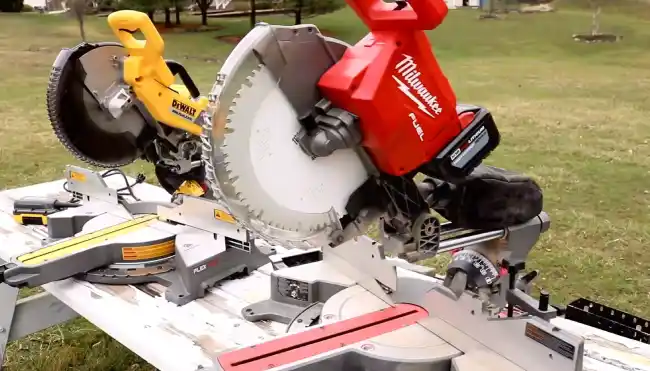
When comparing corded and cordless miter saws, there are several key points to consider. Here are most important ones:
- Power source
- Size and weight
- Storage capacity
- Ease of use
- Reliability
- Precision and project type
- Environment
Let’s check each of these points in more detail.
No 01: Power Source
To power your miter saw, you can choose between a corded model that needs to be plugged in or a cordless model that runs on rechargeable batteries.
A corded miter saw requires a 110/120V electrical supply and provides consistent power as long as it is plugged in. This means you don’t have to worry about running out of power during extended use.
On the other hand, a cordless miter saw is powered by rechargeable batteries, typically 18v or 54v. While it offers portability and the freedom to work anywhere without being restricted by power outlets, it is important to note that the battery life will determine how long you can use the saw before needing to recharge or replace the battery.
No 02: Size and Weight
The corded miter saw is generally larger and heavier compared to its cordless counterpart. With a size ranging from 8 to 12 feet and weighing up to 65 pounds, it offers a sturdy and robust construction. This larger size provides stability and durability, making it suitable for heavy-duty tasks.
Conversely, the cordless miter saw is smaller and lighter, weighing up to 50 pounds. This compact size allows for easy maneuverability and portability, making it ideal for working in confined spaces or transporting to different job sites. Despite its smaller size, the cordless miter saw still offers ample power and performance.
No 03: Storage Capacity
A cordless miter saw has more storage capacity than its corded counterpart due to its lack of power cables. This allows for a more organized and efficient workspace without the clutter of tangled cords. The absence of power cables is especially advantageous in small workshops or job sites where space is limited.
The cordless miter saw can be easily stored in compact areas, such as tool boxes or shelves, without the need to accommodate for the length and bulkiness of power cables. This increased storage capacity allows for better organization and accessibility of the cordless miter saw.
Corded miter saws require power cables, which means they take up more space and can be less convenient to store. Plus, the cords can easily become tangled and make it difficult to access the miter saw. As a result, corded miter saws are not as suitable for tight workspaces or limited storage areas.
No 04: Ease of Use
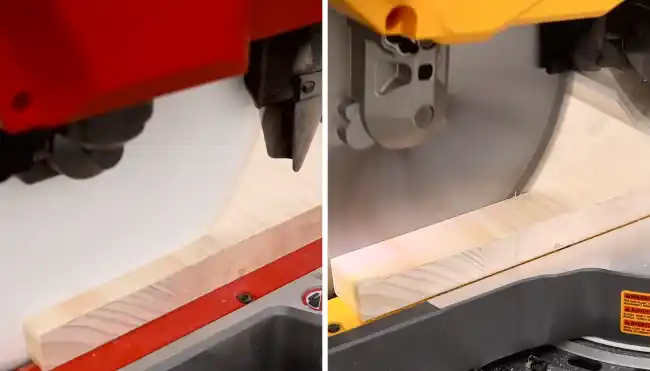
Many users consider ease of use when choosing between corded and cordless miter saws.
Corded saws require a power outlet, which means you may need to drag a bulky extension cord around with you to reach your work area. This can be time-consuming and frustrating, and the cord can also get in your way while you’re trying to work.
In contrast, cordless miter saws can be used anywhere without needing to be tethered to an outlet. However, their ease of use solely depends on battery life management. You need to ensure that the saw is fully charged before using it and keep it charged throughout the cutting task.
Once the battery drains, you need to recharge it, which might consume some time.
No 05: Reliability
Corded miter saws are generally considered more reliable due to their consistent power source. With a corded miter saw, you don’t have to worry about the battery dying or losing power during extended use.
On the other hand, cordless miter saws, while convenient, may be less reliable in terms of staying charged, especially for extended use. However, newer cordless models are improving in this aspect, with some able to make up to 334 cuts of 2×4 lumber on a single charge.
No 06: Precision and Project Type
In order to achieve precision, the choice between a corded and cordless miter saw becomes crucial.
For larger or more intricate projects that demand utmost accuracy, such as creating intricate furniture pieces or custom cabinetry, a corded miter saw is highly recommended. With consistent power supply, you can make precise cuts without any interruptions, ensuring your project turns out flawlessly.
In contrast, if you’re tackling smaller home improvement or DIY projects like installing baseboards, crown molding, or building a small garden shed, a cordless miter saw is more suitable. Its portability allows you to maneuver easily and make accurate cuts wherever needed.
No 07: Environment
The environment plays a crucial role in determining the efficiency and convenience of your tools.
With a corded miter saw, you are dependent on a stable power supply and sufficient power outlets. This can be a challenge in areas where power cuts are common or when working in remote locations without easy access to electricity.
Conversely, a cordless miter saw provides you with the freedom to work anywhere, regardless of power availability. It runs on rechargeable batteries, allowing you to tackle your projects without interruptions or the need for external power sources.
Comparison Table Between Corded and Cordless Miter Saw
| Features | Corded Miter Saw | Cordless Miter Saw |
| Power Source | Requires 110/120V electrical supply | Powered by 18v or 54v rechargeable batteries |
| Size and Weight | Larger (8-12″) and heavier (up to 65 lbs) | Smaller (8-12″) and lighter (up to 50 lbs) |
| Portability | Limited mobility due to cords | Greater portability, not restricted by cords |
| Storage Capacity | Takes up more room due to power cables | More storage capacity without power cables |
| Ease of Use | Consistent power, no battery management required | Convenient for portable tasks, battery management |
| Reliability | Generally more reliable with consistent power | Less reliable in terms of staying charged |
| Precision & Projects | Suitable for precise and larger projects | Suitable for smaller home improvement and DIY |
| Environment | Ideal for areas with stable power supply | Preferred in areas with power cuts or limited access |
Pros and Cons of a Corded Miter Saw
To make your decision easier, consider the following benefits of a corded miter saw:
- A corded miter saw offers more cut capacity and doesn’t require batteries. This means you can make larger and more precise cuts without worrying about running out of power.
- Corded miter saws typically have a slower blade speed, which can be advantageous when working with delicate materials or making intricate cuts.
- Corded miter saws have a sturdier build and are often designed to be more durable, making them able to withstand heavy use.
- Corded miter saws are generally less expensive compared to their cordless counterparts.
However, it’s important to note the potential drawbacks of a corded miter saw:
- A corded miter saw requires you to run an extension cord to power it, which can be slightly inconvenient.
- Corded miter saws tend to be heavier and less portable than cordless options.
Pros and Cons of a Cordless Miter Saw
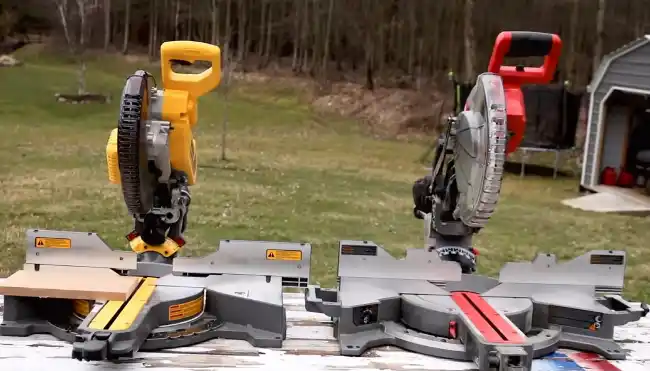
Now that you’ve learned about the advantages and disadvantages of a corded miter saw, let’s shift our focus to the cordless miter saw’s advantages and disadvantages.
Pros of Cordless Miter Saw:
- Portable and lightweight
- No need for power outlets
- Easier to store due to smaller footprint
- No power cords to deal with
Cons of Cordless Miter Saw:
- Higher blade RPM can affect precision of cuts
- Slightly reduced vertical and horizontal cut capacities
- May require larger batteries for frequent use
- More expensive, especially for high-end models
- Better suited for contractors who prioritize portability
Can cordless miter saws cut through thick materials?
While cordless miter saws are capable of cutting through a variety of materials, their cutting capacity may be limited compared to corded saws.
The cutting capacity of a miter saw is determined by the size and power of its blade. Most cordless miter saws have blade sizes ranging from 7 to 10 inches, which is suitable for cutting through materials up to a certain thickness.
However, if you need to cut through thicker materials, such as hardwood or thick lumber, a corded miter saw with a larger blade size and more power may be a better option.
You should check the specifications of the cordless miter saw you’re considering to ensure it has the cutting capacity you need for your specific project.
Do cordless miter saws require maintenance?
While cordless saws may require less maintenance overall, it’s still important to keep them clean and well-maintained to ensure they operate optimally.
One of the main benefits of cordless miter saws is their brushless motors, which require less maintenance than those in corded models. This is because brushless motors have fewer moving parts, reducing the risk of wear and tear over time.
However, that doesn’t mean cordless miter saws require no maintenance whatsoever. Like all power tools, they need to be kept clean and free of debris to prevent damage and ensure accurate cuts.
This can be as simple as wiping down the saw after each use and periodically checking for buildup in the blade guard or other areas.
Are corded miter saws louder than cordless ones?
Operating a corded miter saw can be noisier compared to using a cordless one. The reason for this is the higher power output of corded saws, which results in louder operation. When using a corded miter saw, the noise level can be quite significant and may require the use of hearing protection to prevent damage to your ears.
The noise is generated by the motor and the spinning blade, both of which produce vibrations and sound waves. These vibrations and sound waves are then amplified by the structure of the saw, resulting in the loud noise.
In contrast, cordless miter saws tend to be quieter due to their lower power output. However, it is still important to take precautions and wear hearing protection when operating any power tool to ensure your safety and prevent hearing loss.
Which one should I choose, corded or cordless?
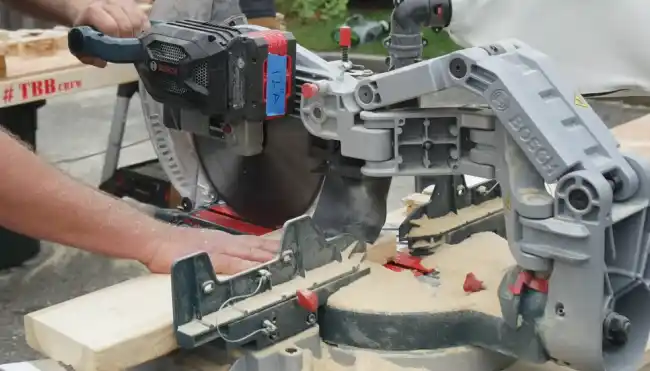
When deciding between the two options, consider your specific needs and preferences.
If you require more power and don’t mind being tethered to a power source, a corded miter saw may be the better option for you.
Corded miter saws offer a consistent power supply, allowing for uninterrupted operation even during long cutting sessions. They are generally more powerful than their cordless counterparts, making them ideal for heavy-duty tasks and cutting through tougher materials.
On the other hand, if portability and convenience are important to you, a cordless miter saw would be a good choice. Cordless miter saws offer the freedom to move around without being limited by a power cord. They are lightweight and easy to transport, making them suitable for job sites or outdoor projects.
Corded or Cordless Miter Saw: Enhance Your Woodworking Project
When considering whether to choose a corded or cordless miter saw, it’s essential to weigh the pros and cons of each option.
While corded miter saws offer consistent power and unlimited runtime, cordless miter saws provide portability and convenience.
However, it’s important to note that cordless miter saws may struggle with cutting through thick materials and require regular battery maintenance.
Additionally, corded miter saws tend to be louder than their cordless counterparts.
Ultimately, the choice between corded and cordless miter saws depends on your circumstances.

